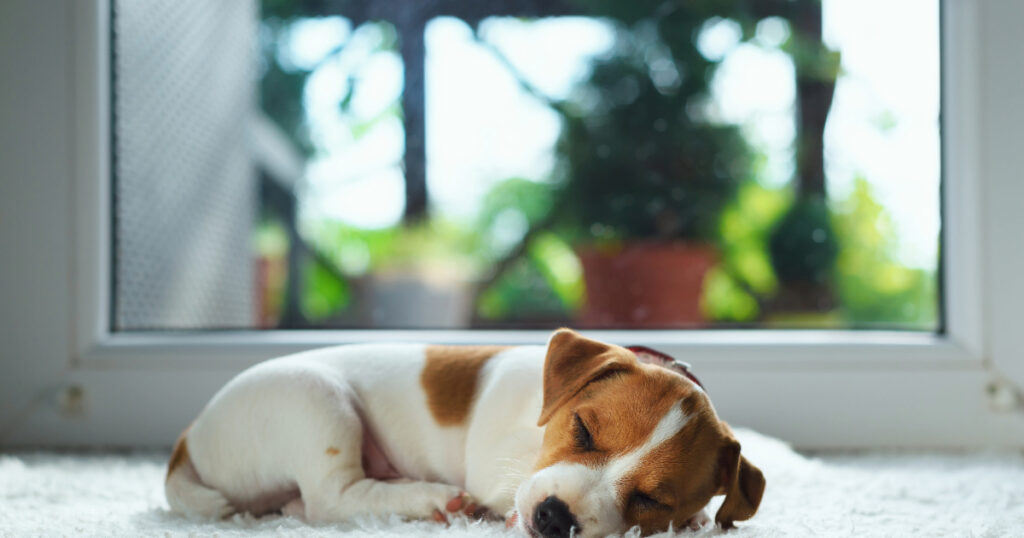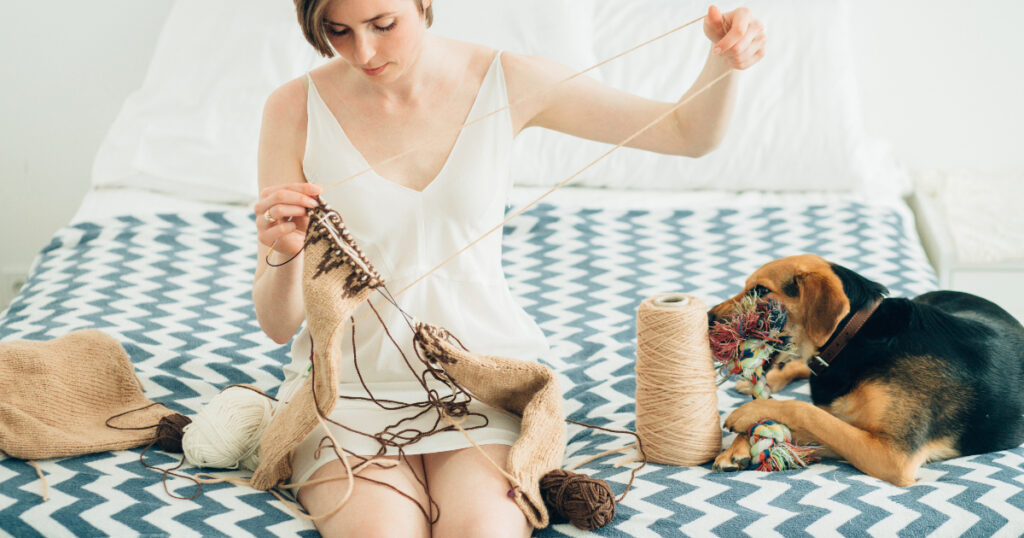Dogs spend a large portion of their day sleeping – anywhere from 12 to 18 hours on average! With all that time spent snoozing, it’s important that your furry friend has a comfortable place to catch some zzz.
But do dogs really need a bed of their own or are they fine just snoozing on the floor?
Here’s an in-depth look at the pros and cons of dog beds to help you decide if getting one is right for your pup.
A Dog’s Sleeping Habits

To understand if dog beds are truly beneficial, it helps to first look at a dog’s natural sleeping habits. In the wild, dogs don’t have access to plush doggie mattresses. They make do by:
- Digging out dirt burrows for shelter
- Flattening down grass and leaves for a softer surface
- Curling up next to each other for warmth
This means dogs are quite adaptable when it comes to sleep surfaces. They can get by just fine without a comfy bed. However, domesticated dogs will look for the softest, coziest spot available to them. If you don’t provide a dog bed, your pup may end up sleeping on furniture, piles of laundry, area rugs – whatever they can find to create a nest.
Key Takeaway: Dogs are flexible when it comes to sleep surfaces but do prefer soft, cushioned areas when available.
The Pros of Providing a Dog Bed
While dogs don’t “need” a bed, there are some great benefits to providing one:
Promotes Better Sleep
Hard floors don’t make for very good sleep surfaces. They can be uncomfortable for dogs to lie on for long periods, making it hard for them to fall into a deep, restorative sleep. A cushioned dog bed provides padding and support so your pup can get some quality shut-eye.
Eases Joint Pain
Lying on hard floors day after day can be tough on your dog’s joints. Senior dogs with arthritis will especially benefit from an orthopedic dog bed that takes the pressure off their sore joints. But even younger dogs can benefit from joint-friendly beds as it prevents wear and tear over time.
Provides Security
Dogs view their bed as a safe haven and place of security. Bringing your dog’s bed along when traveling or moving to a new home can help ease anxiety and make them feel comfortable in unfamiliar environments.
Contains Fur and Dander
Dog beds help confine shed fur, dander, and general “dogginess” to one area instead of it spreading all over your home. Beds with removable, washable covers make cleaning up shedding a breeze.
Gives Your Dog Their Own Space
Having a place to call their own can be very beneficial for dogs. Unlike the rest of the house, a dog bed is a space they can use however they want. It can become a comfortable retreat when your pup needs some alone time.
Saves Your Furniture
Providing an inviting dog bed prevents your dog from claiming couches, beds, and other furniture as their own napping spot. Your furnishings will thank you!
Key Takeaway: Dog beds provide many perks including better sleep, pain relief, security, and more – but aren’t required for a dog’s wellbeing.
Potential Downsides of Dog Beds
Dog beds aren’t perfect though. There are a few potential downsides to providing a cushy sleeping spot:
- Cost – Dog beds can range from $20 to over $200 depending on size, materials, and features.
- Takes up space – Dog beds are bulky, especially for large breed dogs. Make sure you have room for your pup’s bed before buying.
- Can encourage chewing – Dog beds provide another tempting surface for puppies and anxious dogs to chew. Supervision is key.
- Require regular laundering – Beds get dirty and need to be washed frequently, especially if your dog is prone to accidents or excessive shedding.
- May go unused – Your dog may ignore a pricey new bed and just sleep on the floor like they’re used to.
Key Takeaway: Dog beds aren’t always a perfect solution. Consider your dog’s habits before investing in one.
Choosing the Right Dog Bed
If you do want to provide your furry BFF with a comfy place to sleep, put some thought into choosing the right bed for your pup. Here are key factors to consider:
Size
Make sure to get a dog bed that allows your dog to lie down comfortably without limbs hanging off the sides. Measure your sleeping pup from nose to tail for the best fit.
Materials
Orthopedic beds provide the best support for aging, injured, or large-breed dogs. Avoid overly plush beds that can hurt joints. Machine-washable fabrics make cleaning a breeze.
Style
Bolstered and nesting beds are great for dogs who like to curl up. Flat cushions or mats work well for stretch-out sleepers. Get a bed with high enough walls for dogs who like to rest their head.
Durability
Dogs can be rough on beds. Look for tough, chew-resistant beds made with sturdy frames and rip-proof fabric if your pup is destructive. Avoid beds with removable stuffing.
Key Takeaway: Choosing the right size, material, style, and durability of bed for your specific dog prevents waste and ensures your pup will actually use their new bed.
Are Elevated Dog Beds Better?

Elevated dog beds that lift your dog off the floor are also an option to consider.
Benefits of elevated beds include:
- Increased air circulation to keep your dog cool
- Easy to clean and allows dirt/hair to fall through
- Provides orthopedic support without being too hard
- Gets dogs up off cold, damp floors
The downside is that they can be more expensive than a basic cushion bed. But for senior or mobility-challenged dogs, the health perks often make elevated beds a smart choice.
DIY Dog Beds

If you’re crafty and want to save money, consider making your own DIY dog bed. You can customize it to your dog’s size and style preferences. Use new, sturdy materials so it lasts – no old lumpy pillows! Add a removable cover for easy washing. Make sure to supervise your dog at first to ensure they don’t try to chew and ingest any bed parts.
Should Dogs Sleep in Human Beds?
While a dog bed is great to have, some owners also enjoy snuggling with their pups in bed. The ideal compromise? Have your dog sleep in your bedroom but provide them with their own dog bed as well. That way they can choose to nap with you or snooze solo. Dogs should never be forced to sleep in a human bed if it makes them uncomfortable.
Frequently Asked Questions
Are dog beds really necessary?
While not essential, dog beds provide comfort and health benefits that allow dogs to sleep soundly. Most dogs appreciate having a space of their own even if they occasionally still nap on the floor or other spots.
How many beds does a dog need?
One bed is fine to start, but having 2-3 beds around your home gives your dog options to nap in their favorite spots. Purchase crate beds, outdoor beds, and beds for your home for the best comfort.
Do orthopedic beds really help dogs?
Yes, orthopedic beds provide extra cushioning and support for joints, hips, and elbows. They’re especially beneficial for senior dogs or those prone to arthritis and dysplasia. Even younger dogs can benefit from joint-friendly beds.
Should I spend a lot of money on a fancy bed?
You don’t need to splurge on luxury beds with fancy fabrics or frames. Focus more on choosing the right size, material, and shape for your dog’s needs. But do make sure to buy a durable, well-made bed suited for your dog’s sleeping habits.
Why do dogs need beds?
While technically not an absolute necessity, dog beds provide comfort, improve sleep, ease joint pain, and give dogs a sense of security – making them very beneficial for a dog’s health and happiness.
What kind of bed is best for my dog?
Consider your dog’s size, age, joint health, and sleeping habits when choosing a bed. Orthopedic beds are great for senior or large dogs. Bolsters and nesting beds work for dogs who curl up. Flat cushions are good for stretch-out sleepers.
How do I get my dog to use their bed?
Place dog beds in rooms your dog spends a lot of time in so they’re inclined to use it. Provide positive reinforcement like treats and praise when they nap in their bed. And limit access to furniture and human beds so your pup doesn’t default to those areas. With time, they’ll learn to love their dog bed.
Should I let my dog sleep in my bed?
Letting dogs sleep in your bedroom (but not in your bed) has been shown to help humans sleep better. Having your dog close by provides comfort but they may disrupt your sleep by moving around if allowed under the covers. Provide a dog bed in your room for closeness but uninterrupted rest.
How often should I wash my dog’s bed?
Ideally, dog beds should be washed weekly to keep odors, dirt, and hair at bay. Having a removable, washable cover makes this easy. Spot clean accidents right away. Some beds also allow the entire mattress to be thrown in the washing machine for a deep clean.
Conclusion
At the end of the day, while not essential, providing your furry pal with a comfortable dog bed is recommended for their health, happiness, and overall quality of life. Having a dedicated sleeping space just for them promotes better sleep, eases joint pain, and gives anxious dogs a place of security.
Dog beds also protect your home furnishings from being taken over by your four-legged friend. Focus on choosing the right style, size, and materials to suit your pup, and they’ll be catching Zzz’s in comfort for years to come. Both you and your dog will sleep better at night knowing they have a cozy bed to call their own.

